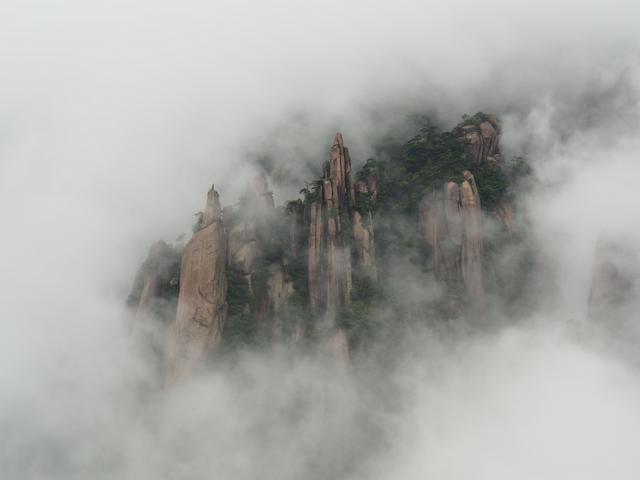Mount Sanqingshan National Park is a UNESCO World Heritage Site and UNESCO Global Geopark in Jiangxi.
 The mountain has three major summits and its name indeed translates to "Three Pure Ones". The highest one, Yujing (玉京峰)., is 1819.9 m above sea level. The mountains are one of the 72 sacred Taoist "sites of happiness".
The mountain has three major summits and its name indeed translates to "Three Pure Ones". The highest one, Yujing (玉京峰)., is 1819.9 m above sea level. The mountains are one of the 72 sacred Taoist "sites of happiness".
The mountain features spectacular rock formations and massive pillars, covered with twisted pine trees and ancient rhododendrons, and has several loops of broad concrete trail, in many cases attached to the side of a cliff. It's somewhat less crowded than similarly spectacular mountains, for the time being.
The park's total area is 229.5 km².
The mountain has been a place of Taoist worship for over 1500 years, and its remoteness protected it from the turmoil of the 20th century. The first ropeway was built in the 1990s, and the second about a decade later. It became a National Geopark in 2005, a UNESCO World Heritage Site in 2008, and a UNESCO Global Geopark in 2015.
Sanqingshan is a mass of granite located on the Suzhou–Dexing Translithospheric Fracture Zone, an ancient plate boundary. The rock spans over a billion years of geologic history.
The mountain has three major summits and its name indeed translates to "Three Pure Ones". The highest one, Yujing (玉京峰)., is 1819.9 m above sea level. The mountains are one of the 72 sacred Taoist "sites of happiness".
Park admission costs 150¥ most of the year, or 130¥ in January, with discounts for children, students, and seniors. A one-way trip up the ropeway is 70¥, and descending is 55¥.

 Sanqingshan has a large number of strangely-shaped rocks and twisted trees. Many of the trees are ancient rhododendrons, so the mountain is covered in flowers in May.
Sanqingshan has a large number of strangely-shaped rocks and twisted trees. Many of the trees are ancient rhododendrons, so the mountain is covered in flowers in May.
The spectacular rock features are clustered mainly in the southern half of the mountaintop area. It is possible to hike over and around a number of large rocks in the Longevity Garden., and perhaps the most famous stone pillar resembles a giant python emerging from the mountain (巨蟒出山)..
There's also an ancient Taoist temple, Sanqinggong (三清宫)., toward the north end of the mountaintop, with a series of sights arranged around it and with various carvings and gates on the path up the mountain to its entrance. This has been a place of Taoist worship for over 1500 years.
The old stone trail to the summit is not marked or maintained, but appears on most maps and can be climbed in under an hour. There is a small shrine at the top.
The spectacular rock features are clustered mainly in the southern half of the mountaintop area. It is possible to hike over and around a number of large rocks in the Longevity Garden., and perhaps the most famous stone pillar resembles a giant python emerging from the mountain (巨蟒出山)..
The spectacular rock features are clustered mainly in the southern half of the mountaintop area. It is possible to hike over and around a number of large rocks in the Longevity Garden., and perhaps the most famous stone pillar resembles a giant python emerging from the mountain (巨蟒出山)..
There's also an ancient Taoist temple, Sanqinggong (三清宫)., toward the north end of the mountaintop, with a series of sights arranged around it and with various carvings and gates on the path up the mountain to its entrance. This has been a place of Taoist worship for over 1500 years.
The main activities here are hiking and admiring the rocks and trees.
Food is available in various places on the mountain, but in all cases it is expensive compared to the base of the mountain. The major hotels all have restaurants. Away from the hotels, there are several small huts selling snacks, instant noodles, and fried chicken.
Stay on marked trails. Be prepared for rapid weather changes and colder temperatures than at the base of the mountain.
Consider visiting the small old towns and terraced fields of Wuyuan, or the old villages of Hongcun and Xidi. Huangshan is also nearby if you want to see more rocks and trees.
